
View Latest Data |

|
Log-in Register |
||||||||||
| Count | Photo | Details | Added  |
| 1,701 | 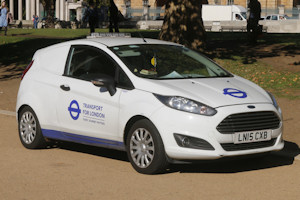 |
By Stuart Hicks A reminder of warmer and happier days now, with this shot of TfL Ford Fiesta van 7986F parked at Hyde Park Corner on 9th October 2018. For some reason, this van was often parked here, close to the Wellington Arch. Well, I say often, but it was just three occasions. Six Fiesta vans (and two cars) carried this generic white/blue livery between 2015 and 2019. It is presumed that the role is now performed by the Toyota Yaris cars new in 2019, though reports of the latter have been scarce. |
14/01/2021 |
| 1,702 | 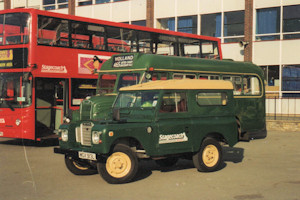 |
By Ray Monk Ray recently unearthed this photo of Land-Rover MGX913L at the Crown Woods car show in Eltham (an event he organised) on 17th October 1999. In the background are preserved Guy bus GS15 and brand-new Stagecoach Dennis Trident TA56, the latter being borrowed from training duties at Plumstead Garage to attend (and also to provide bus rides to the equally-new Millennium Dome). MGX913L was of course new to London Transport as 1761LR in 1972. Withdrawn in 1982 it was restored by apprentices, repainted red and windows fitted in the previously plain sides. Used as a display vehicle for a few years, it later passed to bus company East London, being repainted emerald green with gold Stagecoach logos by 1995. By 1999, the gold East London logos had been replaced by white Selkent ones, and the spare wheel from the bonnet (added during its renovation) had been removed again. This reminded me that I was contacted in 2018 by the current owner of this vehicle who asked if I wanted any photos. Unfortunately he never got back to me. Perhaps I should send a nudge... |
14/01/2021 |
| 1,703 | 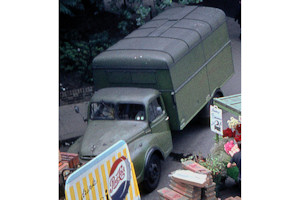 |
By Bill Taylor From 9079VW in 2020 to 979AS in 2021, except of course that this photo was not taken in 2021! Evidently cropped from a larger photo, this was taken in July 1962 by the late Bill Taylor, and reached me via his son Bernard and Clive Greedus. It shows unique Austin BMC 'tin-front' van 979AS parked outside Embankment Station, as viewed from the Charing Cross bridge footways. The quality is not great but colour pictures from this era are always of interest. 979AS was new in 1957 and initially used by the Lifts and Escalators section before transferring to CDS Group 3 in 1960. Note the sliding hatch in the roof, presumably to allow long loads such as poles to be carried. There were also hatches in the front of the body for the same reason. Service vehicles were often to be seen parked at this location. There was a large substation (or similar) nearby, plus it seems to have been used by some drivers as a place to take a lunch break. Indeed one of the two other photos of 979AS on this website shows it at the same location. I would have liked to have seen more of the Pepsi-Cola truck in the foreground, while it is notable that there is still a flower stall nearby today. |
14/01/2021 |
| 1,704 | 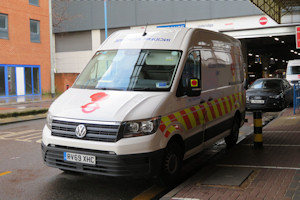 |
By John Woolf Uxbridge Bus Station has an allocation of three Incident Response Unit vans but it is normal to find only one or two present, the remainder being outstationed to locations such as Harrow. On 19th December 2020 John found 9079VW on site, with 9073VW parked behind. Both were from the batch delivered in February 2020 before the COVID-19 situation delayed further deliveries. As such, they both have 69 registrations, and both still carry remembrance poppies on their bonnets. |
22/12/2020 |
| 1,705 | 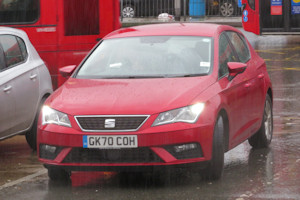 |
By John Woolf Seen at Edgware Bus Station during some mucky weather on 19th December 2020, this unmarked red Seat Leon hatchback car is actually used by Arriva London as a crew ferry vehicle (as is the unidentified silver Vauxhall Corsa parked alongside). Arriva has a presence in Edgware having operated several local routes from its Garston garage. When that closed the remaining routes were transferred elsewhere, and the cars now to be seen at Edgware are believed to come from Palmers Green. Garston to Edgware was 7 miles as the crow flies, while Palmers Green to Edgware is over 8 miles. At least seven Seat Leon cars like this one are now operated by Arriva's Dartford Garage, GK70COH being the first to be based elsewhere. |
22/12/2020 |
| 1,706 | 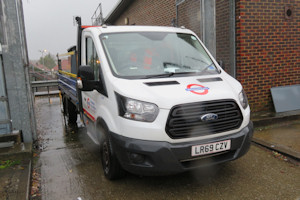 |
By John Woolf LUL Power Supply Ford Transit dropside truck 8989F was photographed at Edgware on 19th December 2020. It was parked on a short alley off the ramp down to the bus garages (where 8853F was parked) that serves a building adjacent to the railway tracks. It is presumed that this is a substation or similar, and it is perhaps notable that there used to be another largish building on the opposite side of the ramp here that also looked to be related to electrical supply. The latter building (visible in the background here) has in recent years been demolished to make way for more bus parking space. |
22/12/2020 |
| 1,707 | 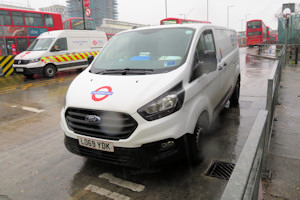 |
By John Woolf Some late arrivals from John Woolf persuaded me to bump up today's batch of photos to a nice round 20. On a wet 19th December 2020 he visited Edgware Bus Station and found a couple of LUL vehicles present. First up is Ford Transit Custom van 8853F parked on the ramp down to the bus garage, with resident LBSL IRU 9065VW in the background. 8853F has not been reported since it was new at Acton in January 2020. It is most likely operated by the Power Supply section, as they have most vehicles in the number range 8843 to 8862, and they also use dropside 8989F which was parked nearby (q.v.). However, 8853F is one of several that have yet to be seen at the department's main base in Tufnell Park. It seems likely that a few smaller bases are also in use. |
22/12/2020 |
| 1,708 | 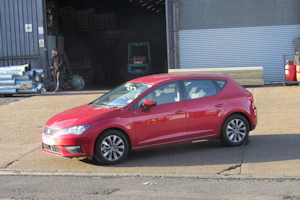 |
By Ray Monk From late-2019 the Seat Leon appears to have become the new standard crew ferry car for Arriva London, with seven added to the Dartford allocation, and at least one now at Palmers Green (q.v.). Dartford's newest so far is anonymous red GK70CPF, seen leaving the garage on 1st December 2020. The building in the background is attached to the bus garage but is used by a warehousing company. |
22/12/2020 |
| 1,709 | 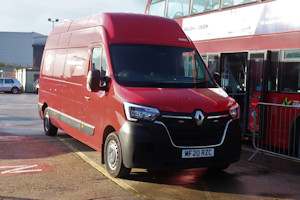 |
By Derek Everson Allocations for several of the thirteen Renault Master vans delivered to RATP in mid-2020 are still required. Derek knocked another one off the list when he found R70035 (MF20RZC) parked at Park Royal garage (the former First London premises on Atlas Road in Harlesden) on 15th December 2020. These vans are rather large, as shown by comparison with the bus parked alongside. |
22/12/2020 |
| 1,710 | 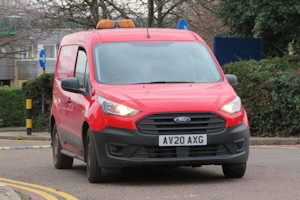 |
By John Woolf John captured this fine view of Metroline Ford Transit Connect van AV20AXG leaving West Perivale Garage on 12th December 2020. The van was new in mid-2020 and is based here, as evidenced by the PA lettering in front of the mirrors. We have had reports of seven 20-registered Transit Connects with Metroline, but I reckon there might be a few more. At least nine of the similar but 15-registered Connects were withdrawn at around the same time. |
22/12/2020 |
| 1,711 | 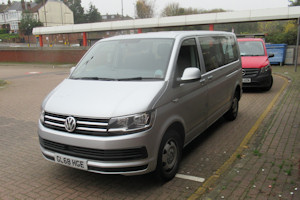 |
By Ray Monk This unmarked silver Volkswagen Transporter minibus seen at Eltham Bus Station on 30th November 2020 was initially thought to be an Arriva London vehicle, perhaps acquired as a replacement for recently-withdrawn CT68CKG. However, further observations have shown that it is in fact operated by Go-Ahead London from Orpington Garage. Given Go-Ahead's use of a large quantity of red Mercedes Vito minibuses (like RF19UZN parked behind), I suspect GL68HGE will be a temporary addition, perhaps to facilitate greater social distancing by limiting the amount of people on each crew ferry run. |
22/12/2020 |
| 1,712 | 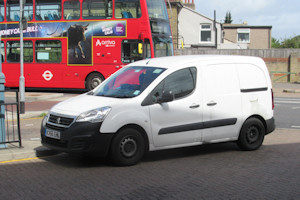 |
By Ray Monk On the basis of several observations at Bexleyheath Bus Stand (as here on 21st August 2020), we reckon that this unmarked white Peugeot Partner van is used by the engineers at Arriva London's Dartford Garage. It had perhaps replaced Vauxhall Vivaro FP64WZB, withdrawn in August. Arriva has taken over quite a few local bus routes over the past decade, including the 401 on which DW429 was working. |
22/12/2020 |
| 1,713 | 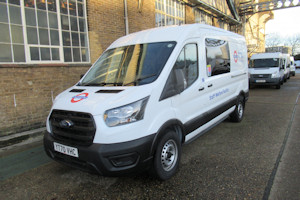 |
By Ray Monk Two new Ford Transit 'Staff Welfare Facility' vans were seen at Acton Works on 5th December 2020, this view showing YT70VHC. Notable is the fact that lettering has been applied but no fleetnumbers, and that the vans are in plain white, lacking the usual blue skirt and red stripe. Ray speculated that perhaps both fleetnumbers and skirts were still to be added, though I reckon it is just as likely that these will be considered to be part of the lorry fleet and hence not be assigned fleetnumbers. Time will tell. Similar YT70VHD was parked nearby, while in the background can be seen ten-year old 6987F still in white/blue/lilac but having recently had its TfL Taxi-Private Hire 'Compliance Enforcement' lettering removed. The unknown with this van is whether it is awaiting disposal or has been reassigned to a different department. The final piece of guesswork associated with this photo concerns the two facility vans delivered in September 2020, YT70VHZ and YT70VJE. It looks as though that pair may have only been on loan pending the delivery of YT70VHC and YT70VHD. |
22/12/2020 |
| 1,714 | 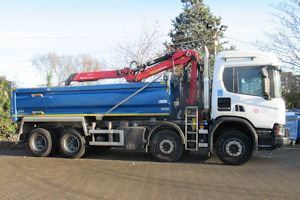 |
By Ray Monk It looks as though Scania 4-axle grab-loader MV69KVM is indeed a full-time service vehicle rather than being a hire as was first thought. It can regularly be seen in the lorry yard at Acton Works (as here on 5th December 2020), and it has been confirmed that the side lettering is properly applied and not just on labels. This side-on view shows more detail of the hydraulic grab arm and the bar attached to a roll-out cover for the loadspace. I was wondering about the purpose of the horizontal handrail above the cab windows, but it is perhaps just to facilitate cleaning of the cabsides, as there is also a large footstep just behind the cab door handle. Looking at Ray's earlier photo of this lorry, I noticed there is also what looks to be a handrail in the sunvisor above the windscreen, possibly for the same purpose. |
22/12/2020 |
| 1,715 | 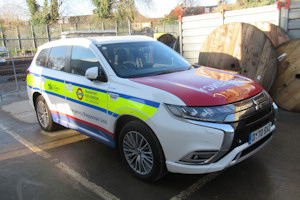 |
By Ray Monk The Mitsubishi Outlander car seen newly-delivered to Acton Works in October was soon given full LUL livery with emergency-style blue-edged yellow bands on the sides, and mirror writing on the bonnet. Assigned to the Emergency Response Unit and given the fleetnumber 9162MIT, it seems to be a belated replacement for Volvo car LM66UNH, withdrawn in March 2020. The role had been covered in the interim by Toyota Prius cars in standard LUL livery. 9162MIT was photographed near the back of Acton Works on 5th December 2020. |
22/12/2020 |
| 1,716 | 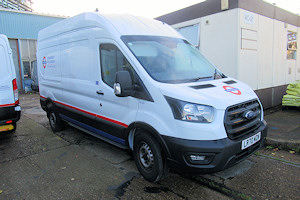 |
By Ray Monk A pair of newly-delivered Ford Transit vans were found at Acton Works on 5th December 2020, and both were in the full white/blue/red livery of LUL. Following the addition of some plain white Volkswagen Crafter vans in October, I had wondered if the livery was to be simplified as an economy measure. This photo shows long-wheelbase, high-roof 9137F, with slightly smaller (medium-wheelbase, mid-height) 9138F on the left (and reflected in 9137F's sides). |
22/12/2020 |
| 1,717 | 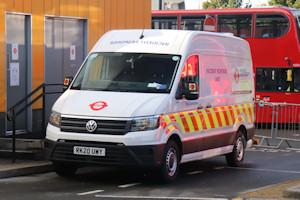 |
By Derek Everson Stratford City Bus Station now has a full allocation of five Volkswagen Crafter Incident Response Unit vans. 9096VW was photographed on 6th October 2020 when it was parked in the main bus station on the opposite side of the railway. |
22/12/2020 |
| 1,718 | 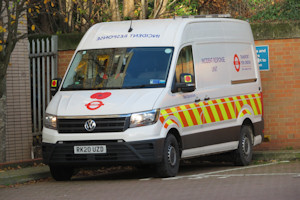 |
By John Woolf Kingston Cromwell Road no longer appears to have a 'permanent' allocation of service vehicles, with vans from Morden attending when required. John found 9071VW parked in the corner bay on 5th December 2020, still showing its bonnet poppy. |
22/12/2020 |
| 1,719 | 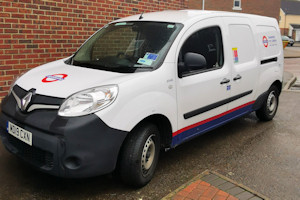 |
By Ivor Norman LUL vans in Essex part 4. A very tight shot of Renault Kangoo Maxi van 8944R parked in Harlow on 14th November 2020. This is another night-time van, which we reckon works out of Lillie Bridge Depot. |
22/12/2020 |
| 1,720 | 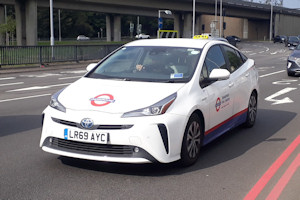 |
By Malcolm Conway LUL Power Supply section Toyota Prius car 8891T was caught on Redbridge Roundabout on 21st September 2020, when it paid a brief visit to the nearby station. I was going to make a joke about this moonlighting as a taxi (based on the positioning of the roof sign on the car behind) but I can't be bothered now. |
22/12/2020 |
| 1,721 | 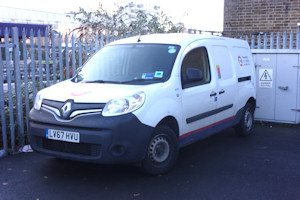 |
By London Spotter LUL vans in Essex part 3. A bit of a cheat on this one, as Barking has not officially been in Essex for many years. The small yard on Wakering Road, adjacent to Barking Station, is normally home to 3 or 4 Volkswagen vans, but when visited on 15th December 2020, the only occupant was Renault Kangoo Maxi van 8555R. We had allocated this van to Lillie Bridge, on the basis of a single sighting there in 2017. However, it has also been seen near Acton Works several times. In the absence of official information, the allocations shown on this website are only as accurate as the observations allow. Complicating the matter is that the ongoing COVID-19 pandemic has no doubt changed some working practices. Hopefully someone will pay another visit to Barking in the next month or two and let us know whether 8555R is still there. Or maybe someone will come across the Volkswagens (8702/4/5/8VW) somewhere else.... |
22/12/2020 |
| 1,722 | 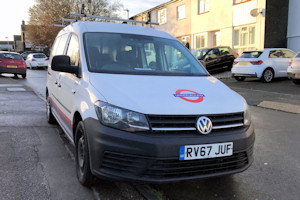 |
By Philip Hambling LUL vans in Essex part 2. Staying in Basildon, this view captured on 17th December 2020 shows Volkswagen Caddy Maxi crew van 8521VW. Part of the large Stratford Market Depot allocation, this van works mainly at night and had not been photographed before. |
22/12/2020 |
| 1,723 | 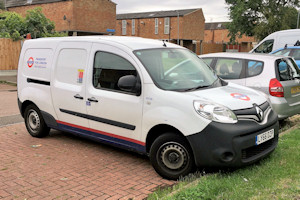 |
By Philip Hambling LUL vans in Essex part 1. Renault Kangoo Maxi van 8373R was new in early 2017 and has been noted a few times at Edgware Road Station or near the neighbouring Griffith House. On 10th August 2017 it was found parked in Basildon. |
22/12/2020 |
| 1,724 | 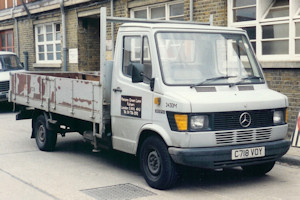 |
By Colin Lloyd Now, this photo does (fairly) clearly show the support prop under the front of the bodywork on some of the C/VOY Mercedes trucks, here in a raised position but with the round, pivoted 'foot-plate' discernible. What were these for? It is hardly conceivable that there was a risk of these vehicles tipping over, even whilst using the small hoists some were fitted with (2430M did have one in the nearside front of the body, a hint of the orange device just being visible through the windows). As for the details, this is 2430M parked on the rear entrance roadway to Chiswick Works on 4th May 1987. It is in original 'work force' livery, albeit with some of the paint peeling off the body. Ironically the other photo of 2430M on this website was also taken by Colin at the same location, but a year earlier and on the other side of the roadway. |
15/12/2020 |
| 1,725 | 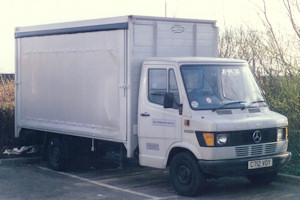 |
By Philip Hambling I have decided to add a couple more photos to today's batch, hence these appear out of fleetnumber order. The reason is to show the under-body props on the C/VOY-registered Mercedes 307D trucks, which I only discovered when writing the caption to this photo a couple of hours ago. Unfortunately this area is not clearly visible in most photographs, due to a combination of the shade and of the print scanning process losing more detail and contrast. However, these two photos hopefully show what I am talking about. This is Mercedes 307D truck 2426M at Ferry Lane on 27th March 1988. If the photo looks familiar, it is because I have already published a photo taken by Keith Grimes on the same day, though that was added over 16 years ago so you must have a really good memory! Anyway, Phil captured a slightly different angle, and there is something visible below the front of the body, just behind the corner post. There are a couple of further points about this vehicle that I did not mention first time around. Two of the eight C/VOY 307D trucks (2426M and 2429M) were bodied as curtainsiders, though to two different designs, and both were different again from the ten C/WLB curtainsiders (2445-2454M) delivered later in 1986. 2429M was the most conventional-looking, with hand tensioners fitted along the bottom edge of the curtain. As an aside, I have just realised that the under-body prop is also visible in the photo of 2429M! Anyway, the C/WLB trucks (like 2454M) had curtains with horizontal ribs, suggesting that they opened by rolling upwards towards the roof. 2429M has curtains that appear to open sideways, but there are no tensioners. Also, while there are securing latches at each end, there don't appear to be any handles to open and close the curtains. Both 2426M and 2429M had ladder hatches in the front end, but 2426M's front was planked and had a Southfields label in the center (the body maker presumably) while that on 2429M was plain metal. The rear arrangement on 2426M and 2429M is not known, and there may have been doors. 2445-2454M are known to have had plain sheet fronts and backs. |
15/12/2020 |
| 1,726 | 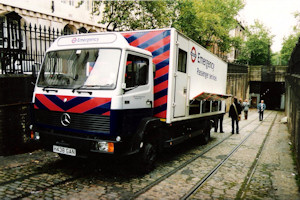 |
By Damon Cross This interesting photo shows Emergency Passenger Services Mercedes 1114 demountable 2496M (most likely with body DB2 mounted) parked on the ramp to the Kingsway tram subway on 15th August 1992 during public visits. Following the formation of the Emergency Response Unit in 1992, the side lettering on the bodies was later changed from 'Passenger services' to 'Response unit'. When the ERU received a new fleet of Mercedes Vario and Volvo FL lorries in 1998/1999, 2496M was sold, along with similar 2492-2495M. The Kingsway tram subway is a remarkable survivor, at least in part. Opened in 1906, the subway was originally intended as a means of joining-up (via Waterloo Bridge) the London County Council's two separate tram networks, but legal problems resulted in it emerging on the Embankment underneath Waterloo Bridge, rather than on it. The north entrance was on Kingsway near the crossing of Theobalds Road, and the tunnel included the only two underground stops on the London tram network. After the last trams ran in 1952, the tunnel was disused for several years, until most of its length was used for a new road underpass that opened in 1964. Due to the restrictive width of the tunnel, this was a one-way road, and it rose to the surface much nearer the Strand than the original tram tunnel. This left the northern section of the tunnel, and the access ramp (as shown here) intact and, as of 2020, no permanent use has been found for them. I had a real sense of deja-vu while researching and writing this caption, as if I had only recently been doing the same thing. However, I could not find any earlier photos in which I would have mentioned the subway. If I have unduly repeated the information then I apologise. Now, where did I put my slippers? |
15/12/2020 |
| 1,727 | 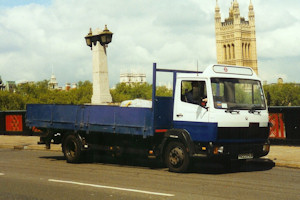 |
By Colin Lloyd Another photo by Colin of demountable 2491M but this time there are a couple of points to note. Taken on Lambeth Bridge on 6th May 1997, the lorry is in general haulage use, with the Emergency lettering and chevrons removed from the front. However, most of the emergency Mercedes demountables were not replaced until the Volvo FL6 lorries arrived in October 1998. The answer again comes from the Rennie/Aldridge book. 2491M was in fact different to the other emergency demountables, in that it was allocated to (and lettered for) the permanent way department rather than the rolling stock department, and its body (DB1) was fitted out differently. The creation of the Emergency Response Unit in 1992 combined work for both departments, and the non-standard 2491M was deemed to be surplus to requirements. I now realise that 2491M was actually the only emergency demountable to have a second career in general haulage. The other ERU trucks were disposed of following replacement. The other matter is to do with the body carried. There is a number painted on the 'solebar' of the body near the front. Although being in black lettering makes it hard to read, I am fairly sure this is DB13. Most demountable bodies were later modified with a cutout in the solebar to clear the larger wheels of the Volvo FL6 lorries. DB13 seems to have gone through various further changes. First it lost its twin dropside doors, retaining just the head- and tail-boards. It was then modified to have three solid doors on each side (instead of two) and side-hinged rear doors, though when seen it only had the rearmost side doors fitted. More recently, the solid metal doors have been replaced by ones with mesh panels, still only towards the rear. |
15/12/2020 |
| 1,728 | 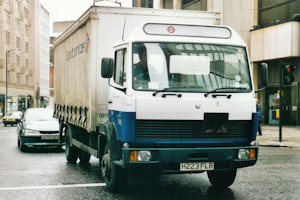 |
By Colin Lloyd Mercedes 1114 demountable lorry 2491M has already made five appearances on LTSV, but I am adding a further two today. The first view is simply a good photograph, showing the lorry on Artillery Row, crossing Victoria Street, on 18th April 2000. 2491M was one of the demountable lorries that were used for emergency duties when new, as evidenced by the illuminated headboard that originally had 'Emergency' lettering but which now shows just the roundel. 2491M was to remain in general haulage use until 2006 (when it was replaced by new MAN LE demountable lorries), and it was often used in combination with curtainsided body DB15, as shown here. Built by Locomotors in 1993, DB15 was still in use as of early 2020. |
15/12/2020 |
| 1,729 | 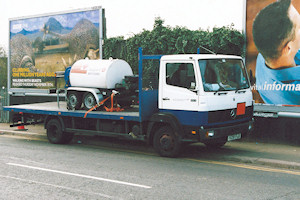 |
By Derek Everson Fleetnumbers 2485M to 2490M were applied to a batch of six Mercedes 814 lorries all of which had been licensed on 1st August 1990 (the first day of H-prefix registrations), though they were not all taken into stock straight away. 2488M was a demountable and was the only 814 demountable alongside a dozen of the larger 1114 model. It was for use with the new Emergency Control Unit body DB7 but curiously, although DB7 was new in September 1990, 2488M was not officially taken into stock until almost exactly a year later. 2490M was a box truck, while the other four were all dropside lorries, similar to earlier 2469M/2470M apart from having two drop-doors on each side instead of three. 2485M, 2486M, 2487M and 2489M were all delivered in red livery, rather than the new LUL white/blue, perhaps because they were intended for use by the bus companies. Indeed 2485M and 2486M were allocated thus, and passed to Leaside and London United respectively upon privatisation. 2487M and 2489M were also allocated to bus garages (Brixton and Stockwell respectively) but their destinies were different. 2487M was taken over by LUL in about 1996 and repainted white/blue, also losing its dropside doors to become a flatbed. It was photographed parked on Park Royal Road on 4th November 2001, when it was carrying Indespension tanker trailer T70. T70 was mainly used to allow on-site refuelling of track machines, and it was often to be seen carried by a lorry rather than being towed, perhaps because of roadworthiness issues. 2487M remained in stock until 2008, while T70 was eventually replaced by a new trailer by 2018. The last of the dropsides (2489M) is a bit of a mystery. It seems to have also transferred to Acton in about 1996 and is reported to have been repainted white/blue, but the only photo of it which I have seen shows it in red livery in 1992, and it was sold in 1998. According to the excellent 2003 book by Kim Rennie and Bill Aldridge, all six 814 lorries were originally intended to be demountables for emergency use. It was soon realised that heavier chassis would be required, and a batch of Mercedes 1114 demountables was ordered in replacement. |
15/12/2020 |
| 1,730 | 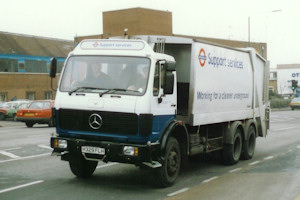 |
By Colin Lloyd Mercedes dustcart 2483M was photographed in Alperton on 19th December 1990, when the lorry was just three months old. The large slogan along the bodysides still has the original lower-case u on underground, this being changed to a capital U not long after. There is a 'basket' under the nearside of the body, and this was later adapted (at least on similar 2482M) to include a clinical waste container. The pipe ends later seen in this area on 2482M are not present and there is also no 'GLC Exempt Vehicle' label. The latter was soon applied, even though the GLC had ceased to exist in 1986. 2483M was withdrawn in 1997 with no obvious replacement, while 2482M remained until 2000 and was replaced by the first of the Mercedes Econic dustcarts. |
15/12/2020 |
| 1,731 | 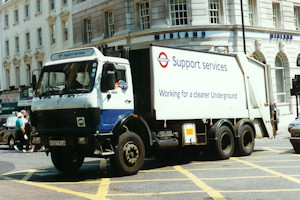 |
By Colin Lloyd The 21 Mercedes lorries delivered in 1990 included two dustcarts based on the 2421 chassis with SK-series 'day' cabs and Norba compactor bodies. Replacing two of the 1985 Dodge Commando dustcarts, the Mercedes were in the new standard LUL white/blue livery with huge 'Support services' lettering and 'Working for a cleaner Underground' added underneath. 2482M seems to have been photographed a lot more than sister 2483M, and it was seen passing through Victoria on 12th July 1994. The 'Clinical waste' compartment below the bodywork, and the two circular items nearby (inlet/outlet pipes?) are not original features, having been added in about 1993. Note that a 'GLC Exempt Vehicle' label is also displayed. |
15/12/2020 |
| 1,732 | 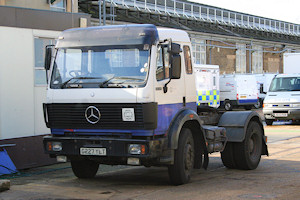 |
By Damon Cross One more photo of Mercedes 1726 artic tractor unit 2474M today, this one being taken at Acton Works on 6th March 2007, less than a year before the lorry was sold. The traces of the original red livery are still visible, as is the faded 'GLC exempt vehicle' label on the radiator grille. Come to think of it, the latter is a bit odd. The Greater London Council was abolished in 1986, yet 2474M was not delivered until 1990! Also visible are a pair of new Ford Transits for Metronet, and two British Transport Police vehicles. Leaning against the building on the left are some blue doors which are probably off a service vehicle, possibly being from the back of a dropside lorry. |
15/12/2020 |
| 1,733 | 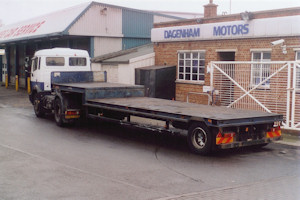 |
By James Mair Another photo of 2474M, again by James, and again being shown more for the trailer than the lorry itself. Taken at the Dagenham Motors premises in Hayes on 19th December 2004, 2474M had by this time gained Tube Lines logos. The trailer is Crane Fruehauf single-axle step-frame CT39, new in 1984 in grey livery. As a photo added last week shows, this originally had removable side panels around the lower flatbed section. CT39 was taken out of use by early 2006 and was dumped at Acton Works for a few years before being sold in 2009, thus outliving 2474M by one year. The question now is why a Mercedes lorry was visiting Dagenham Motors, which specialised (unsurprisingly) in Ford vehicles. The Hayes premises were adjacent to the GW mainline and the yard could be seen from passing trains. It often contained a service vehicle or two, though it is not known if they were an actual supplier to the central fleet. It could be that vehicles were taken here for repairs and/or MOT, and indeed one-year old Transit van 5591F was also present on this date. So, could it be that 2474M and CT39 had been used to bring a broken-down van here for repairs? Perhaps, though CT39 lacked the rear ramps found on larger T60. |
15/12/2020 |
| 1,734 | 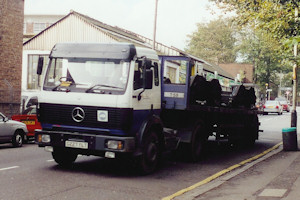 |
By James Mair After taking two batches of Mercedes 307D trucks in 1986, a pair of larger 814 lorries were added at the very end of 1987, followed by a couple of artic tractor units in 1988/1989. It was in 1990 that Mercedes became a major supplier to the central fleet, with 21 vehicles of varying sizes taken into stock. The first of these was 2474M, a 1726 artic tractor with the familiar SK-series cab and delivered in February. Although new, it arrived in a red livery rather than the standard grey, suggesting it may have been from dealer stock. The new LUL white/blue livery was introduced at about this time, and 2474M was soon repainted thus, with 'London Transport, Distribution Services' lettering. James caught it coming down Bollo Lane in Acton, showing traces of the former red livery underneath the radiator grille. I have included this photo mainly for the trailer, which is Boden 2-axle flatbed T59 acquired in 1994. This has not appeared on LTSV before, and it was disposed of in 2002 after a relatively short life. |
15/12/2020 |
| 1,735 | 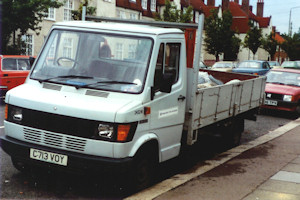 |
By James Mair 2432M is another of the C/VOY Mercedes 307D which seems to have only been photographed once, and I am grateful to James for capturing this view. It was found parked in Burnt Oak probably in about 1990. As with most of the dropside trucks, 2432M had been used by the Works and Buildings section when new, but had later been transferred to the Permanent Way Manager, as evidenced by the cabside lettering seen here. The only other lettering is the fleetnumbers, which appear to be smaller than those carried earlier by other trucks from this batch. Like 2431M, this truck has what looks like a small hoist in the front of the body. Unfortunately I cannot make out whether there is also a support strut underneath. |
15/12/2020 |
| 1,736 | 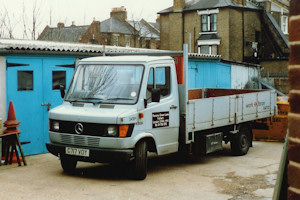 |
By James Mair Another of the C-VOY registered Mercedes 307D trucks, 2431M is in the livery carried by several of the batch for their first few years. This featured large 'work force' lettering on the bodywork, with a smaller LRT Builders label, while the cabsides featured the Parsons Green Lane address. As this is the only photo I have of 2431M, I cannot say whether the livery was later changed. A couple of details of the vehicle are of interest (to me at least!). The locker below the bodywork seems to have been fitted on some (but not all) of this batch, and this one has had LRT Builders lettering applied. Just in front of this is what looks like an extendable support strut, of the type often found on demountable bodies. It is not very clear here, but also appears on several other photos I have of vehicles from this batch, both the dropsides and the curtainsiders. There is no sign of any support at the rear of the bodywork on this (or any other) photo, so I doubt that these were in fact demountable. Could it simply have been to support the vehicle while loading/unloading? Finally, and possibly connected to this, there is something orange in the body just behind the cab, which could well be a removable hoist. The location of this undated photograph is the small Junction Road premises in Upper Holloway. The houses in the background (with their distinctive buttresses) are on Monnery Road, which leads to the back entrance to Holloway Garage. |
15/12/2020 |
| 1,737 | 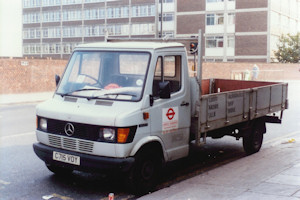 |
By James Mair Correcting what I said in the caption to an earlier photograph of this vehicle, the first Mercedes service vehicles used by London Transport were actually some specialised vehicles acquired in 1983/1984. These comprised a pair of Unimog road/rail trucks and three 310 bullion vans. However, the 307D trucks that followed in 1986 were perhaps the first 'normal' Mercedes service vehicles, having the standard grey livery and fleetnumbers. Delivered in the spring of 1986 were eight 307D trucks, of which six had dropside bodies. Three (edit: now four) of those six are being shown today, but they all carry different lettering. First up is this view of 2427M (fleetnumber not carried), parked outside Wembley Park Station on 12th August 1990. Originally carrying 'work force' lettering for LRT Builders (as seen on similar 2431M) and fleetnumbers, it later lost its numbers and received new lettering in two round-cornered boxes per side, the upper box containing 'Distribution Services' and the lower box 'Transport Contractors' along with a phone number. The remains of the lower box can still be seen in this photograph, but the upper box has been covered by a larger label for London Transport Distribution Services. This was already out of date, since the 01 telephone prefix had been changed to 071 in May 1990. Perhaps more interesting is the marking on the bodywork, this reading 'London Underground, Machine Shop, Lillie Bridge' in stencil lettering. 2427M was replaced by similar 2544M in 1993 and was exported. |
15/12/2020 |
| 1,738 | 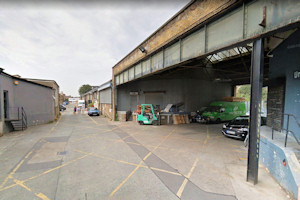 |
By Google As well as aerial and 3D views, Google also provides 'street-view' images for most roads. Interestingly, the roadway that bisects the Parsons Green site is now publicly accessible, and it has been visited by the Google camera cars, with views available all the way up to the small yard at the far end. This view is taken from near the 'top' (North East) end, looking back towards the entrance on Parsons Green Lane. The buildings on both sides are now used by a variety of private concerns, while shown here is one of the covered areas which might have been used in London Transport days for the parking of lorries and plant. Having said that, there does appear to be a small yard at the other side of this area, with vehicle access also from Harbledown Road. This is presumably the location featured in Julian's photo, and where a young Ray used to climb the walls! |
08/12/2020 |
| 1,739 | 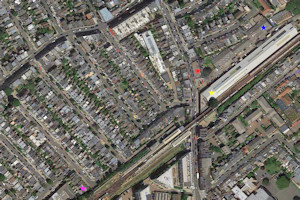 |
By Google The recent photos of Parsons Green prompted me to look into this location. Although closed in (about) 1987, the premises has remained largely the same as when it was used by London Transport. Shown here is an aerial view recently taken from Google. The long, grey-roofed building on the right is the main part of the works, with the yellow star marking the covered loading bay that appears in many photos due to it being close to the entrance. The string of buildings on the other side of the roadway were also used by LT, and included some more covered areas, the one marked with a blue star appearing in the next photo. The red star marks the main office building, located on Parsons Green Lane and visible in other photos. It is currently occupied by a variety of users, including a bridge playing club! I have left this photo wide to also include a location I did not previously know about. Marked with a pink star in the bottom left, this was a small yard that appears to have been used as an overflow parking area for LT lorries. On the corner of Whittingstall Road and Beaconsfield Walk, and adjacent to the District Line tracks, several photos previously published on LTSV are now thought to have been taken here (like this one, this one and this one added last week). Although only a couple of hundred yards from the main works, the direct route looks like it has only ever been a pedestrian walkway. Lorries would presumably therefore have had to travel via Fulham Road (across the top left corner of this photo). The yard appears to have been redeveloped in the 1990s, with a short row of 4 new houses built adjoining the 3 older ones between there and the junction with Lettice Street. |
08/12/2020 |
| 1,740 | 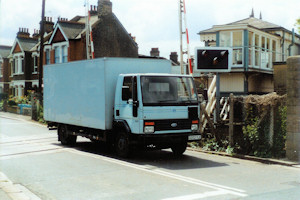 |
By James Mair Ten more Ford Cargo lorries were bought in autumn 1986, these getting a mixture of C- and D-prefix registrations. Three were given box truck bodies, including 2442F shown here. This is yet another lorry of which I only have the single photograph, and again it is thanks to James. He caught 2442F crossing the railway tracks on Bollo Lane (Acton) on 1st May 1989. 2442F was the lightest of the Ford Cargo box trucks, being a Cargo 0811 (note the slim wheelarches) and lacking a tail-lift. It remained in use until 1995 and was repainted white/blue. The attractive signal box in the background is still in place in 2020, though now unmanned and boarded-up. It has also lost the curious extension, which had presumably been added to allow the signalman a clearer view of both of the level crossings at this location. |
08/12/2020 |
| 1,741 | 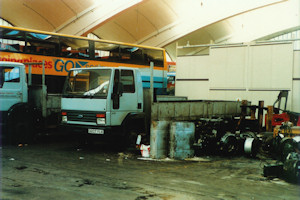 |
By James Mair Here is yet another 1980s lorry that only appears to have been photographed by James Mair. Having said that, I never did get to scan more than a portion of Colin Lloyd's large collection of service vehicle photographs. Fortunately his photos are now safe but they are not going to be accessible for a while yet. Anyway, this is Ford Cargo 0809 dropside lorry 2438F, new in 1986 and destined to last for less than six years. Note that the only lettering carried appears to be the fleetnumbers. Keeping 2438F company were Dodge Commando dropside 2385D and one of the Scottish Citylink MCW Metroliner double-deck coaches. |
08/12/2020 |
| 1,742 | 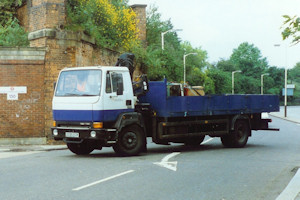 |
By James Mair Here is Leyland Freighter 2435L again, this time entering Acton Works in 1993. The lorry had by then been repainted into the white/blue livery, but what is slightly interesting is that the dropside body had originally been repainted black (see Colin's photo from February 1991). The strip under the windscreen was black on new Leyland T45s, it being designed by Ogle to give the impression that the windscreen was deeper than it actually was. Having said that, the panel was also used for the large Leyland lettering. On 2435L this had been repainted (or replaced) plain white, as also happened to 2372L and 2395L when they were repainted. Curiously, later 2464L managed to retain the black strip. 2435L remained in service until 1999 when it was sold and exported. |
08/12/2020 |
| 1,743 | 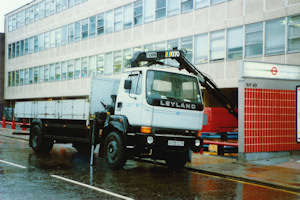 |
By James Mair 2435L was very similar to earlier 2397L in being a Leyland Freighter 1613 dropside lorry fitted with a HIAB crane behind the cab, the main difference being the solid headboard to the bodywork. New in grey in October 1986, it had a modified version of the 'pinstripe' livery, with 'Distribution Services' now in block lettering. Note that the registration number has no relation to the fleetnumber. The practice of obtaining matching numbers (wherever possible) ended with 2424D (C424BYH) in late 1985. James found 2435L at Jamestown Road in Camden, using its crane to place (or remove) something in the adjoining premises. Number 10 Jamestown Road had become a service vehicle location in about 1983 when the publicity vans previously at Baker Street moved here. As can be seen, there were offices above and vehicle parking spaces slightly below street level underneath. Most of the service vehicle photos taken at this location were in the latter. The department was renamed London Transport Advertising (as seen on the sign here) and was later sold off as TDI, while this location is thought to have been used until the mid-1990s. It has now been redeveloped, with flats above and a string of restaurants on the ground floor. |
08/12/2020 |
| 1,744 | 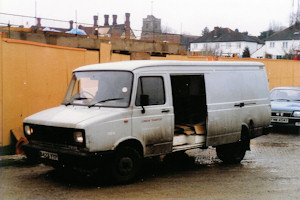 |
By James Mair Following the adoption in 1982 of a new fleetnumber series (from 3000 upwards) for leased service vehicles, there was a fairly clear split between the two fleets. Cars and small vans went in the leased series, while heavy lorries remained in the original series. For some mid-sized types the distinction was less defined. Most Ford Transits were in the leased fleet, but a few were given 'owned' numbers. For the Sherpa vans, the split seems to have been based on the size. After 1982, Sherpas to the original size (later known as Sherpa 200s) were added to the leased fleet. However, a larger variant was later introduced (badged as Freight Rover Sherpa 300s or 400s), and several of these joined the 'owned' fleet in the 1980s. 2423L was one of a pair of 350 vans acquired in spring 1985. Similar 2422L lasted for almost 12 years, was displayed at one of the Chiswick Works open days and was later repainted from grey to white/blue. By contrast, 2423L only survived for a little over three years, being withdrawn in 1988. Fortunately, James (again) managed to catch it, the only photographs I have seen being a couple taken by him at a murky (and muddy) Pinner Station. This was during the construction of the supermarket on the station approach road. Note the slightly impractical use of white transfers for the fleetnumbers and department lettering. |
08/12/2020 |
| 1,745 | 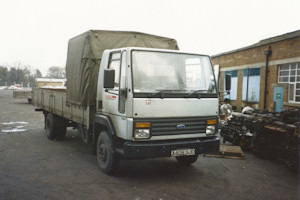 |
By Derek Everson From about 1987 until at least 1994, half of Fulwell Bus Garage was used by LT/LBL as a storage point for withdrawn buses awaiting disposal, replacing the previous use of the former AEC factory site in Southall. The large yard at the rear was included as was the entrance on Stanley Road (visible in the distance in this photo). Derek visited on 11th December 1987 and found three service vehicles present, perhaps being used to move components recovered from withdrawn buses (such as the engines visible on the right) back to garages for use as spare parts. One of these was Ford Cargo dropside lorry 2408F, new in late 1983 and transferred to Cricklewood garage after a short spell at Parsons Green. It was later listed as being based at Fulwell, though it appears to have been withdrawn in 1990 after a relatively short life. When photographed it still had a quarter tilt cover fitted, though there was no fixed section to the bodywork as was previously normal. The tilt was removed by 1989. 2408F was one of the lighter Cargo models, being based on an 0809 variant. The main visual indicator of this is the narrower wheelarches fitted. The other lorries present were both Ford D-series, with the back end of 1979F just visible behind 2408F. Photos of this and 2223F will be added soon. |
08/12/2020 |
| 1,746 | 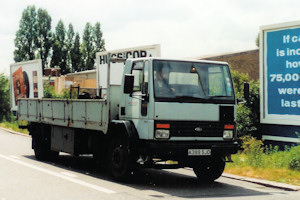 |
By James Mair 2399F was another of the four Ford Cargo 1613 dropside lorries bought in October 1983 and was photographed heading up Bollo Lane in Acton on 1st May 1989. Although 2399F remained in stock for the same 13 years as 2398F, this is the only photo of it that I have seen. The lorry was last recorded by the DVLA as being white and licensed until June 1997. Since it was only sold in October 1996 it might be logical to assume that it had (like 2398F) gained LUL white/blue livery in the early 1990s. |
08/12/2020 |
| 1,747 | 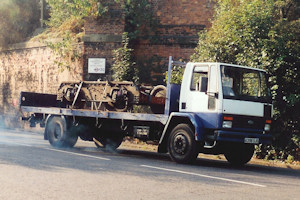 |
By James Mair Another view of Ford Cargo lorry 2398F in white/blue livery, this one taken on Bollo Lane (Acton) some time after the Hounslow photo. The dropside doors have been removed, converting the lorry to a flatbed, while the non-standard white fleetnumbers have been replaced with normal ones on the front corner panels. |
08/12/2020 |
| 1,748 | 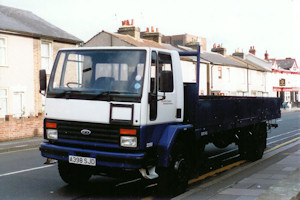 |
By James Mair Several of the Ford Cargo lorries bought by London Transport in the early 1980s lasted into the mid-1990s and managed to be repainted in the newish white/blue livery. 2398F was one of these, being a long dropside new in October 1983. It was photographed in Hounslow (between the bus garage and Hounslow East station) on an unrecorded date. The livery application is fairly standard, apart from the use of large white transfers for the fleetnumber (without the F suffix). |
08/12/2020 |
| 1,749 | 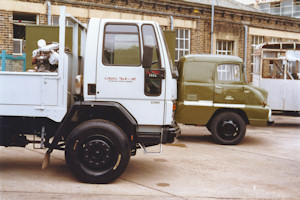 |
By Derek Everson Ford Cargo dropside 2398F was another lorry to be on display during the 11th August 1985 open day at Chiswick Works, and a photograph taken then has already been published. This view has been added as it shows a nice comparison between the Ford lorry designs of the 1980s and the 1960s. 2398F was one of six Ford Cargo lorries new in autumn 1983 with A---SJD registrations. Four of the six were Cargo 1613 lorries with long dropside bodies and no tail-lifts, the other pair comprising a short dropside (2408F) and a box truck (2404F). 2398F was one of the longest-lived of the London Transport Ford Cargos, managing a creditable thirteen years before disposal in 1996. As the next couple of photos show, it underwent some changes during that time. Parked behind is 1282F, a Ford Thames Trader box truck new in 1963 as one of a trio of auxiliary breakdown tenders. 1282F was later converted into a Communications Vehicle and remained in use until replaced by Ford A0609 van 2086F in 1982. As the last survivor of over 130 Ford Thames Traders bought by London Transport, 1282F was retained as a semi-preserved vehicle. It was restored by apprentices and repainted into Chiswick Green livery as worn by many of LT's Traders (though ironically never carried by 1282F itself). Displayed at various events, it was kept at Chiswick Works then at Acton Works before being sold for continued preservation in 2008. There are lots of photos on Flickr of this truck taken since, showing it at various locations and with various registration numbers, liveries and states (some without the box body), and its current status is not known. Finally, at the far right is part of AEC Mercury tower wagon 89Q. As a photo taken the following day shows, work on restoring the bodywork of this vehicle was at a fairly early stage, and the actual tower was yet to be refitted. |
08/12/2020 |
| 1,750 | 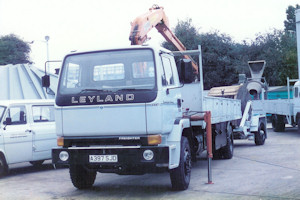 |
By Colin Lloyd Chiswick Works had an open day in 1983 to celebrate the Golden Jubilee of London Transport, and this was repeated in 1984 and 1985. At both of the latter events, Leyland Freighter lorry 2397L was on display in the back yard, and it had its crane extended both times. Photos taken of this lorry on both dates have already been published on LTSV, but I am adding this front view of 2397L at the 11th August 1985 open day because it shows a few differences to the similar 1984 photo. The front bumper has been repainted from grey to black while the London Transport lettering on the cab doors has been replaced by Distribution Services in the curious cursive style used for a few years. This is linked to a pair of pinstripes (in blue and black) which wrap around the front of the cab, broken by a small blue roundel in the center. The stabiliser legs for the crane are in the extended position and the lorry was coupled to cable-drum trailer SEBT42. Beyond that is a cement mixer (still in Chiswick Green?) loaded onto one of the large York trailers, with Dodge Commando dropside lorry 2307D on the right. At the far left is another Dodge, dustcart 2419D, which brings me to the grey Ford Transit minibus. This vehicle appears in the background of several photos taken on this date, but I am still unable to determine its identity. It is registered in the LBK---Y series and has windows all round. This means it is most likely 3010F (LBK673Y), but if anyone is able to confirm this I would be pleased to hear from them. Note that this Transit features hinged side 'cargo' doors, a feature I discussed last month. I have just realised that sliding side cargo doors do not appear to have been available on standard Mk1/2 Transits, only being introduced with the Mk3. Back to the main subject for a minute, 2397L was owned until 1995 and is reported to have been repainted in the post-1990 white/blue livery, although I have no photos to back this up. |
08/12/2020 |
| 1,751 | 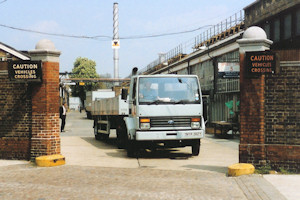 |
By James Mair Two more Ford Cargo articulated tractor units were delivered to London Transport in February 1983, numbered 2382F and 2394F. These differed from earlier 2373F in not having cranes, and also being heavier 1913 models (2373F had been a Cargo 1313. The first two digits of the designation indicate the gross weight and the last two the net engine power). The 1913 was the heaviest Ford Cargo variant used by London Transport, though the range included models up to 3424s for long-haul work. 2382F was caught departing from Parsons Green Works a few years later. It was coupled to one of the 1984 Crane-Fruehauf trailers (CT33) but still had the grey bumper and wheelarches (changed to black by 1988). 2382F was withdrawn in 1993 while trailer CT33 lasted until 2000 and was repainted blue. This photograph is the first on LTSV to show both sides of the Parsons Green facility. Located on a long and relatively narrow site alongside the railway, there was a continuous building on the right (south-east) side, with a series of smaller buildings on the left. The roadway between the two was quite narrow, resulting in some care being needed when moving and parking lorries, and it led to a small yard at the far end. Compare this photo with that of the superb model built by Clive Greedus. More about Parsons Green can be found towards the end of today's batch of photos. |
08/12/2020 |
| 1,752 | 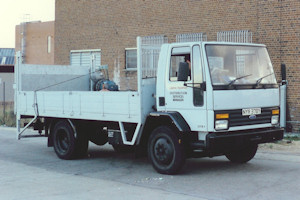 |
By James Mair If 2373F was the 'prototype' for the Ford Cargo with London Transport, then 2378F shown here represents the first 'production' batch. Seven were bought in spring 1983, comprising two further artic tractor units and five dropside lorries, all carrying NYR3--Y registration numbers. The five dropsides were quite varied, two (2380F/2381F) being heavyweight Cargo 1613 versions with long bodies (three dropside doors each side) while 2392F was a light-weight Cargo 0809 with a quarter-tilt. The other two (2378F and 2388F) were both mid-weight Cargo 1011s with short dropside bodies (two doors) and tail-lifts. However, 2378F had wooden doors while 2388F had metal ones, and there were other minor differences suggesting that the bodies had been built by two different companies. Rather strangely, the only photos of 2378F that I have come across are a couple taken by James when the lorry was paying a visit to Edgware Garage. Judging by its relatively smart condition, these were probably taken in about 1983/1984. We don't have a withdrawal date for 2378F but it was most likely in the early 1990s. The lorry then remained in the UK until about 2005 before being exported. |
08/12/2020 |
| 1,753 | 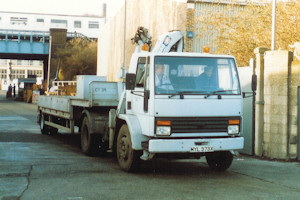 |
By James Mair The last of 143 D-series lorries bought by London Transport was delivered in August 1981 (tipper 2319F) but it was not until the following May that the first example of the replacement Cargo model was taken. This was artic tractor unit 2373F, based on the Cargo 1313 variant and fitted with a crane behind the cab. It was officially a replacement for unique Leyland Lynx 1995L, and it was based at Chiswick Works, being photographed at the back (Bollo Lane) entrance. After 2373F's arrival, there was a gap of nine months until any further Ford Cargo lorries were delivered, resulting in 2373F being the only one with an X-suffix registration. When new, 2373F had a grey front bumper and wheelarches (as seen here), and these also featured on the three other Cargo artic lorries bought (2382F, 2394F and 2444F), while all the rigid Ford Cargos had them in black. Most of the artics were changed to black later on, while 2373F also had a black front dash panel for a time in 1988. 2373F was disposed of in March 1993, following the arrival of Mercedes artics 2525M-2528M, and it is not thought to have been repainted in the post-1990 white/blue livery. Coupled to 2373F in this photo is CT39, a Crane-Fruehauf single-axle step-frame trailer new in 1984 (2373F would have initially operated with the York trailers bought in the 1970s). CT39 did last long enough to be repainted blue, and it was not sold until 2009, having spent a few years dumped at the back of the lorry yard at Acton Works. |
08/12/2020 |
| 1,754 | 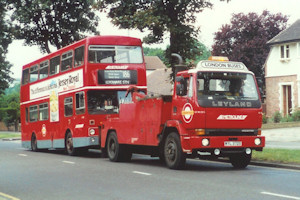 |
By James Mair Leyland Freighter bus recovery truck 2372L has appeared on LTSV several times, but this photo shows it in an intermediate livery not seen before. New in 1982 as the first of a new generation of tow trucks, 2372L spent most of the decade based at Cricklewood Bus Garage. The photo here was probably taken in 1989 or 1990, following the introduction of the 'tape-grey' livery (as carried by the MCW Metrobus being towed) at the end of 1987. 2372L had lost the Cardinal District label from its front, replaced by the logo of newly-formed bus operating unit Metroline (applied in about February 1989), while the plain white roundels on the sides have been changed for the latest white/red/yellow London Buses ones (this occurred after March 1989). The lorry had also switched to its originally-booked registration of MYL372X, having initially operated on trade plates, and had gained a pair of additional front lights below the bumper. Interestingly, it still carried the unique 'Fleet No 2372L' lettering it had from new. This livery was not to last long and, by August 1991, 2372L had been transferred to LUL at Acton Works, repainted into white/blue and given the incorrect fleetnumber 2372M. |
08/12/2020 |
| 1,755 | 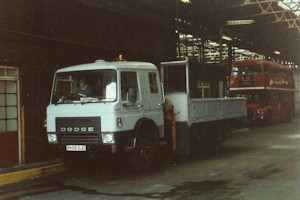 |
By James Mair Having already written 14 captions about Dodge lorries, I am now beginning to get Commando fatigue! But this is the last one and (as usual) I have found something to say about it. 2409D was a dropside lorry with crew-cab, new at the end of 1983. Unlike most of the crew-cab dropsides, it did not have a tail-lift, but it did have a crane (and stabilisers) fitted behind the cab. As this photo clearly shows, this has resulted in the bodywork being mounted further back. Similar lorry 2307D has been listed on LTSV as also having a crane but I now believe this to be incorrect. Firstly, 2307D did have a tail-lift, the provision of both seeming unnecessary. Secondly, the bodywork on 2307D started right behind the cab. In standard grey livery with 'London Transport, Department of Civil Engineer' lettering, 2409D apparently lasted until 1994, with 2420D and (possibly) 2385D being the only Commandos to survive longer. I have noted that 2409D was repainted to the white/blue livery, though I have no photographic proof of this. The location of this photo was initially marked as unknown but further investigation makes me fairly sure it is Wandsworth garage. This garage had a western entrance set back from the main entrance, and this lorry looks to be just inside that. The photo would therefore have been taken from somewhere behind the location of Dodge 2379D in another of James' photos, though they were not taken on the same day. The bus inside appears to be RMC1471, which was allocated to Wandsworth in the mid-1980s, while beyond and to the offside of that is the pits area. |
01/12/2020 |
| 1,756 | 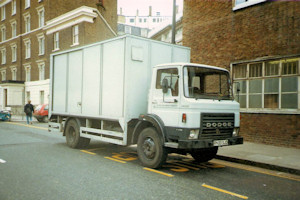 |
By Derek Everson 2400D was unique among London Transport's Dodge Commando lorries in having a short cab coupled with a box body. It also differed from the other Commando box lorries in having sliding doors in the side of the bodywork in addition to the roll-up door in the rear. New just before Christmas 1983, it was allocated to Chiswick Works as part of the general haulage (Group 3) fleet and lasted until 1992. On 16th March 1987 Derek found it parked outside the canteen and offices at Allsop Place, Baker Street. Note that the box body has a ladder hatch in the front and full-length guard-rails below each side. |
01/12/2020 |
| 1,757 | 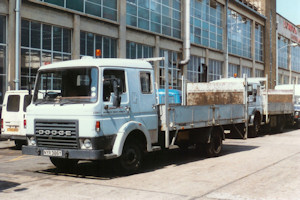 |
By Colin Lloyd Another familiar location, this is Chiswick Works on 4th August 1989, less than a year before closure. Parked near the back yard were a number of service vehicles, headed by Dodge Commando dropside lorry 2386D. A fairly typical example with a crew-cab, tail-lift and metal dropside-doors, the only distinctive features are the weight lettering carried near the front of the body, and the grey wheelarches. The former has been noted on a few other lorries (such as Dodge 2402D), while the latter can be compared to the black ones on the similar lorry parked behind. I don't have any photos of 2386D with black wheelarches so perhaps it retained the grey ones throughout. I have been studying photos to see if there were any visible differences between the various Dodge Commando variants (e.g. G1085, G1185, G1285 and G1685). The first two digits are believed to relate to vehicle weight, with the heavier vehicles presumably having larger engines and/or wheels. Although there are slight height differences visible in some photos, they are too small to be relied upon for recognition. Of the other vehicles visible here, the white Ford Transit on the left was not part of the main service vehicle fleet. The blue Transit minibus just visible above 2386D could be 2458F, while behind the second Dodge lorry is what looks like mobile laboratory 2375D. |
01/12/2020 |
| 1,758 | 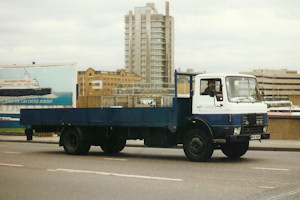 |
By Colin Lloyd London Underground introduced its new white and blue livery for service vehicles in 1990, by which time the fleet of Dodge Commando lorries was already being depleted. A handful survived long enough to be repainted, just two of which have been confirmed by photographs. Dustcart 2420D was one, and shown here is the other. 2385D was one of the long dropside lorries, lacking crew-cab and tail-lift but enabling the movement of larger items. On 4th February 1992 Colin caught it heading north over Vauxhall Bridge, the land behind still being used as a coach parking area. The dark blue of the bodywork makes it hard to tell if it still retained a mixture of wood and metal dropside doors, while the lettering on the cabs reads 'London Transport, Distribution Services'. Despite the livery, such vehicles would still have been used on bus-related work in addition to jobs for the underground, and it seems likely that the lorry was coming from Stockwell Garage when photographed. The date of 2385D's eventual disposal is not known but was most likely in 1993 or 1994, and it was licensed until 2001. |
01/12/2020 |
| 1,759 | 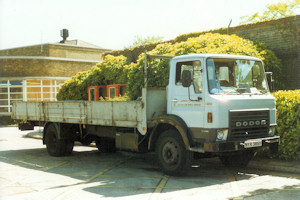 |
By Colin Lloyd I hope you're not getting bored of Dodge Commando lorries yet, because I still have five more photos to show! 2385D is another of the 'long' dropside lorries and was photographed in Acton Works on 27th April 1990. Many of the Commandos were sold around this time but seven-year old 2385D was destined to remain for a few more years, and to gain a repaint. The dropside doors on most of the Commando lorries were of metal construction, except that the last three 'long' dropsides (2383/85/87D) had planked wooden ones. When photographed, 2385D was operating with a mixture of both types. |
01/12/2020 |
| 1,760 | 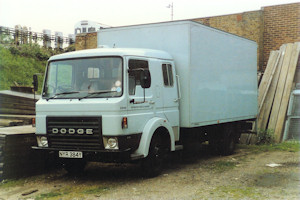 |
By James Mair Today's batch of photos covers all four of the Dodge Commando lorries fitted with box bodwork. 2384D was one of the three that had a crew-cab and tail-lift, and it was another of the type to start out with grey wheelarches that were later repainted black. Other changes apparent in the later photo are the addition of a roof beacon light, and a Renault diamond on the front grille. Following a conversation with James, I now know the location of this photograph, and it is a place I was not previously aware of. About 200 yards south-west of the main Parsons Green Works, there was a small vehicle yard at the corner of Whittingstall Road and Beaconsfield Walk. This appears to have been used for overflow parking, though it has long since been built over. This discovery is useful because I had a few photos marked as Parsons Green (such as this line-up) which I could not relate to the main works. The wall in the background of both photos belongs to an adjoining small industrial premises, accessed from Lettice Street, and still there in 2020. An aerial view showing the area has since been added here. |
01/12/2020 |
| 1,761 | 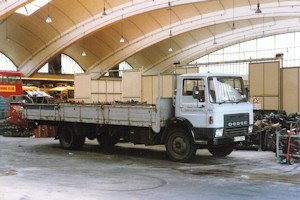 |
By James Mair The distinctive roof design shows this to be Stockwell Garage, which was a good place to find service vehicles until the late 1980s. Stockwell was used as a maintenance (or 'docking') base for many of the heavy lorries owned by London Transport, and it was perhaps unique in having a pit area dedicated to such vehicles. The garage evidently still had room to spare and it was also regularly used to park up Scottish coaches laying over between runs to Victoria Coach Station. Three of these (including an MCW Metroliner double-decker and a Duple 340) can be seen in the background of this photo, as well as one of the home-allocated DMS buses. 2383D was one of several LT Dodge Commando dropside lorries that had the longer bodywork. Such vehicles lacked the crew-cabs and tail-lifts normally found on the shorter variants, and were among the most long-lasting. 2383D had been new in February 1983 and lasted a shade over ten years. |
01/12/2020 |
| 1,762 | 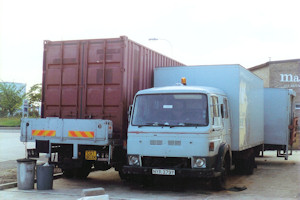 |
By James Mair One more visit to Willesden for today and this view shows the same three vehicles as another photo published today. What I found interesting about this one is that it shows how cosmetic the changes made to the Dodge Commando design in the early 1980s were. As seen, 2379D was a crew-cab box lorry with the later design of front grille. However, by the time of this photo (most likely late 1991), the large black grille had been removed and the lorry now looked very much like the earlier design. Most of the larger 'grille' panel was aesthetic rather than functional, and the panels underneath were unchanged. Note also that the wheelarches had been repainted from grey to black, while the tail-lift on similar box truck 2306D (parked behind) has either been replaced or repainted from grey to reddish-brown. None of these lorries ever worked again. The industrial estate has not changed much over the past thirty years, except that the Magnet building in the background is now used by Car Giant. This area has been in the news recently, with plans for major redevelopment being opposed by some of the current users. |
01/12/2020 |
| 1,763 | 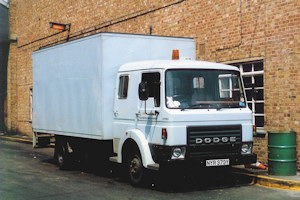 |
By James Mair Of the 27 Dodge Commando lorries bought by London Transport between 1981 and 1985, the majority (20) were dropsides. The remainder comprised four box lorries and three dustcarts. Three of the box trucks had crew-cabs and tail-lifts, though the first of these (2306D) differed in having the earlier front panel design and also ladder hatches in the front of the box bodywork. 2379D was new in April 1983 and was photographed at Wandsworth Garage (outside the set-back western entrance) a few years later. The front wheelarches are grey, while a photo taken in 1988 showed that they had been repainted black (and a Renault diamond had been added to the front grille). As will be shown next, 2379D was one of six LT Commando lorries to end up with a firm in Willesden. |
01/12/2020 |
| 1,764 | 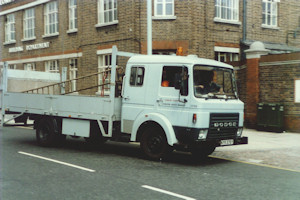 |
By James Mair London Transport seems to have been happy with the ten Dodge Commando lorries bought in 1981, because they came back for more in 1983. Eight were delivered in the spring, all with NYR3--Y registrations, followed by a further six (with A4--SJD plates) towards the end of the year and into 1984. A final three were added in 1985 bodied as dustcarts. All of these featured the revised cab styling, with a larger front grille panel and black plastic mouldings around the headlights and wrapping around to the wheelarches. Although a minor change, this gave the lorries a considerably more modern appearance. Seen arriving at Parsons Green works when still fairly new, 2376D was a dropside lorry with crew-cab and tail-lift. The grey front wheelarches are notable, most LT Commandos having these in black. For a heavy lorry, 2376D had a rather short life. Delivered in April 1983 and based mainly at Chiswick Works, it was delicensed in November 1987 (when less than five years old) and sold the following March. There is a better photo of Parsons Green Works coming up in the next batch but, before I forget, I should mention that a look at Google Streetview might be of interest. This now includes a 'drive' right through the old works up to the small yard at the far end. A lot of the buildings along the way appear to be unchanged from when London Transport last used them in the late 1980s. |
01/12/2020 |
| 1,765 | 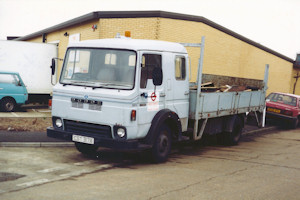 |
By Derek Everson Salter Street (Willesden) again, and another photo taken by Derek on 19th March 1991, this time of former Butterwick (Hammersmith) resident 2317D. Derek gave the location as BEL Willesden, though I suspect that this is actually another one with the neighbouring generator firm. Although the lorry still has a full set of lettering, it is parked on the industrial estate roads (rather than in the BEL premises) and it had not been road-licensed since December 1990. The livery is slightly interesting, the pin-stripes and blue roundels being retained with a newer, white label applied on top. This had a red roundel, London Transport and the phone number 071-227-6497 (a Westminster code?). There may also be a line of text above the phone number but I can't make it out. |
01/12/2020 |
| 1,766 | 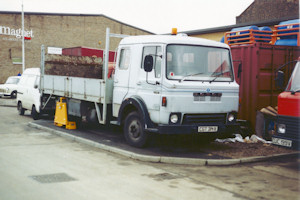 |
By Derek Everson Back to Salter Street (Willesden) again, I chose this photo more for the red lorry visible on the right than the main subject. The grey lorry is Dodge Commando 2314D, which has been shown at this location before. However, this view shows that, even though these lorries were not licensed, they were moved around a bit. The side lettering had been overpainted, leaving just the pinstripes and roundel on the front, and a wheelclamp had been applied. The red lorry is the former 2199F, a Ford D0710 box truck previously used by LT as a railway breakdown tender. The January and February 1992 issues of TLB (The London Bus) state that eight lorries were used by this firm, comprising six grey Dodges along with 2199F and similar 2140F. I then went back to my photo folders and found that both James and Derek had indeed photographed the two Fords here in 1991. Perhaps I will upload one of those photos next time round. 19th March 1991. |
01/12/2020 |
| 1,767 | 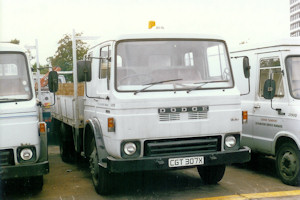 |
By Colin Lloyd The brief popularity of Dodge as a supplier of service vehicles to London Transport is highlighted by this photo taken at Chiswick Works on 13th August 1988. The three vehicles are all Dodges, the main subject being dropside lorry 2307D. This was to the most common configuration for the type, having a crew-cab and tail-lift, and it retains its original grey livery. The lorry on the left is similar and is probably 2314D, this having gained the short-lived blue/black pin-stripes. Note the '100' badging on both lorries (albeit in different positions). This model had originally been designed by Commer in the late 1960s. When Chrysler Europe acquired Commer (with the Rootes Group) in 1967 it was decided to brand the type as the Dodge 100, though the 'Commando' name was also used (but not on the vehicles themselves). The vehicles were built at the former Commer factory in Dunstable. Chrysler Europe was sold to PSA Peugeot Citroen in 1978, with the commercial vehicles section quickly sold on to Renault, although products for UK use continued to be badged as Dodges. On the right in this photo is 2390D, one of five S66 vans bought by LT, and which was withdrawn and sold the following month. |
01/12/2020 |
| 1,768 | 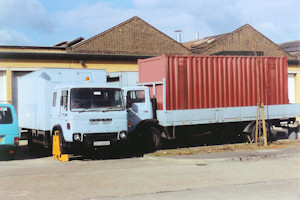 |
By James Mair Having just mentioned the mobile generator company in Willesden, here is the first of a few photos taken at their premises, most likely in 1991. They were located on an industrial estate off Scrubs Lane and they took at least eight lorries from the central fleet. The fact that BEL (Bus Engineering Ltd) had recently relocated to a small premises almost next door may have been a factor. One curious aspect of this situation is that hardly any of the lorries were ever licensed for road use following their disposal by LT/BEL. It appears that the generator company used them simply as static stores vehicles. Three lorries are visible in this view. On the left is crew-cabbed box truck 2306D, while the long dropside loaded with a container is 2303D. Just visible parked behind is 2379D, another crew-cab box truck. All of the lorries retained grey livery and most had had all lettering removed. |
01/12/2020 |
| 1,769 | 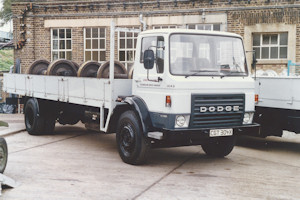 |
By Derek Everson Slightly more successful in LT service than the Bedford TL was the Dodge Commando type. Ten of these were bought in the last few months of 1981, followed by a further seventeen in 1983-1985. 2304D was one of the first ten (all of which had CGT3--X registrations) and was one of the largest, being a long dropside lorry based on the G1685 model. 2303D was similar and delivered in the same month, although it had the earlier design of front panel. 2304D was photographed whilst it was part of the CDS vehicle display at the Chiswick Works open day on 11th August 1985. Destined to last nearly ten years, it was one of several lorries to pass (in 1991) to a mobile generator company based very near the relocated Bus Engineering Ltd premises in Willesden. Licensing data suggest that it was never used as anything more than a static store, and was presumably scrapped not long after. |
01/12/2020 |
| 1,770 | 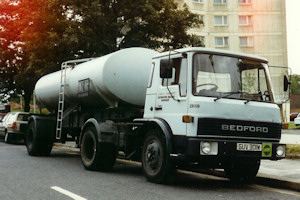 |
By Colin Lloyd For a brief period from mid-1980 to late-1981 the Bedford TL became the standard model for London Transport's lorry requirements. Seventeen were bought in total, most of which were dropside lorries. There were also three box trucks, two artic tractors and a single tanker, and all were delivered in the standard grey livery. One of the tractor units was 2301B, seen here parked (rather unusually) on Lexden Road, close to the junction with Steyne Road in central Acton, on 18th July 1986. It was coupled to BT30, a Buckingham 2500-gallon tanker trailer that was acquired second-hand in 1983 and used for carrying water. The trailer remained in stock into the 1990s but 2301B was withdrawn by early 1987, later seeing use with Billy Smart's Circus. None of the Bedford TLs (apart from tanker 2274B) lasted very much longer, and none are believed to have gained the post-1990 white/blue livery. |
01/12/2020 |
| 1,771 | 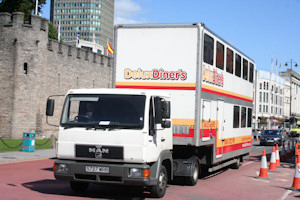 |
By Malcolm Conway Another oddity to end today's batch. This is not the cost-cutting NNBfL (New New Bus for London) but a location dining vehicle. Such vehicles provide seating accommodation for people working at sites without suitable facilities, and the role has often been fulfilled by time-expired buses. They are most commonly associated with on-location TV and movie filming, but have also made appearances at railway engineering works. Examples seen on LTSV include an MCW Metrobus at Stepney Green in 2013 and a semi-trailer (very like the one shown above) at Goodge Street in 2009. This example was actually photographed in Cardiff on 9th September 2009 (possibly in connection with filming of Doctor Who), and it was being towed by a plain white MAN L 2000 8.163 tractor unit. More photos of these trailers (including interior views) can be found on the Delux Diners website at https://www.deluxdiners.co.uk/. All of the trailers seem to have the errant apostrophe in their lettering. |
28/11/2020 |
| 1,772 | 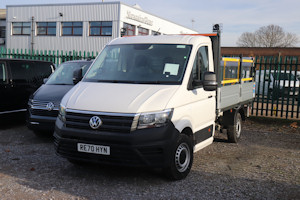 |
By Derek Everson A sign of things to come? There were no obvious service vehicles at the Cordwallis Volkswagen dealership in Bedfont on 24th November 2020, but there were a few plain white vehicles which may yet turn out to be for the central fleet. One of these was VW Crafter dropside truck RE70HYN, as shown here. Apart from a couple of Mercedes Sprinters, all mid-sized dropsides for the central fleet since 2008 have been Ford Transits. Having said that, LUL has taken a few Crafter vans recently, following a large batch for LBSL, and it may be that the type has proved itself suitable. Normally, dropside trucks for LUL would come with blue bodywork, but the fact that the recent Crafter vans have entered service in all white could mean that the livery policies have changed. Note that this truck has the black plastic panel below the headlights and grille, similar to that on the vans at Hainault, but different to the white panel on the LBSL vans and LUL crew vans. |
28/11/2020 |
| 1,773 | 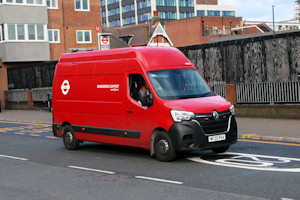 |
By Lee Thatcher RATP followed its batch of 30 Dacia cars with a dozen Renault Master vans in summer 2020, together these replacing most of the existing fleet. Fleetnumber R70030 is carried by MF20RVA, seen passing the Bell in Hounslow on 9th November 2020. Similar R70034 is reportedly based at Hounslow Garage so I suspect R70030 will be at Hounslow Heath, but more sightings are needed before this can be confirmed. |
28/11/2020 |
| 1,774 | 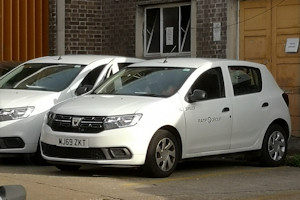 |
By Lee Thatcher RATP acquired a batch of 30 Dacia Sandero cars over the turn of 2019/2020, for use as crew ferry vehicles from the various garages operated by its London United, London Sovereign and Epsom Buses subsidiaries. I reckon this is the largest ever single batch of service vehicles added to a London bus operator's fleet (not including LT of course). Allocations for a few of the cars are still unknown, with reports in 2020 having been reduced due to the COVID-19 situation. Even when vehicles are seen, sometimes it is hard to be certain where they are based. For example, D75117 had been noted working from Hounslow Heath Garage early in 2020, but on 16th November 2020 it was seen parked at the main (older) Hounslow Garage, alongside an unidentified sister. |
28/11/2020 |
| 1,775 | 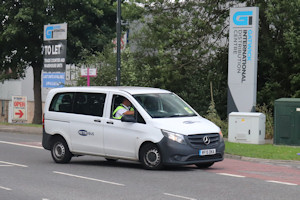 |
By Derek Everson With the bulk of the operation absorbed into Go-Ahead London a few years ago, Metrobus retains just the Crawley garage and is now managed from the Go-Ahead subsidiary to its south (Brighton & Hove) rather than its north. The service vehicle fleet still uses the white livery with neat but restrained markings and 4-digit fleetnumbers. 8031 is one of a pair of Mercedes Vito minibuses acquired in mid-2015 and it was seen, still looking smart, on 6th August 2019 about to turn from Gatwick Road North into the industrial estate where the garage is located. In the windscreen is a sign showing that it is on crew ferry working FB3. |
28/11/2020 |
| 1,776 | 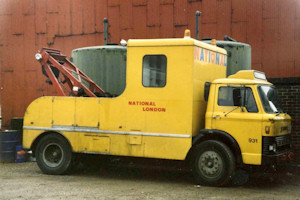 |
By Philip Hambling National Travel London (later just National London) was one of several regional NBC (National Bus Company) subsidiaries that only operated coaches, in this case from a garage in Catford. Control of the company was passed to LCBS (London Country Bus Services) in May 1984, and this resulted in the appearance of National London fleetnames on at least one LCBS service vehicle (43F). The coach fleet was gradually reduced by transfers to LCBS and (from September 1986) the four new regional companies. The end came in February 1987 when the remains of the fleet were taken over by Kentishbus (formerly London Country South East). The only service vehicle known to have originated with National London is this Ford D-series tow truck registered DGP364H. When it was photographed at the Kentishbus garage in Swanley in January 1988, it still retained National London lettering but had gained Kentishbus fleetnumber 931. It was later re-registered Q981JKO and was probably withdrawn in the early 1990s. |
28/11/2020 |
| 1,777 | 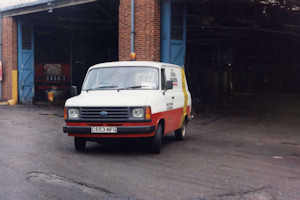 |
By Philip Hambling Taken at Hertford Garage in May 1987 (as was the previous photo), this view shows Gatwick Engineering Ford Transit van C553NFG leaving. This van had been new to London Country Bus Services as 70F in September 1985, this being the penultimate number allocated in their main service vehicle series (there were also service vehicles numbered in the 578F to 586F range as well as a few other oddities, while 71F was allocated to another Transit also new in September 1985). I haven't been able to find out when Gatwick Engineering closed down. The Companies House website lists a Gatwick Engineering Company Ltd incorporated in April 1986 and dissolved in December 1996, though the only address given is that of accountants Touche Ross in Birmingham. Note the traditional 'Fire Station' just inside the garage doors, the sand buckets having by then been replaced by extinguishers. |
28/11/2020 |
| 1,778 | 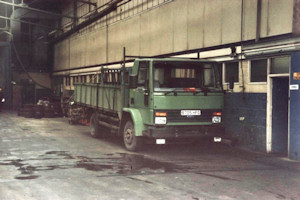 |
By Philip Hambling Last week I showed one of the last three lorries bought by LCBS (London Country Bus Services), and here comes another one. Comparison of this view of 68F at Hertford Garage in May 1987 with the one of 66F at Crawley will show some relatively subtle differences. 66F was a Cargo 0811, while 67F and 68F were Cargo 1011s. The differences include wider mudguards on the cab of the larger lorries, and bodywork that is mounted higher-up and with deeper sides in metal rather than wood. The revised location for the front numberplate may not be of significance. Like 66F, 68F is believed to have passed to Gatwick Engineering in 1986, this perhaps accounting for the lack of lettering in this view. It is not known if it ever gained the new white/yellow/red livery. |
28/11/2020 |
| 1,779 | 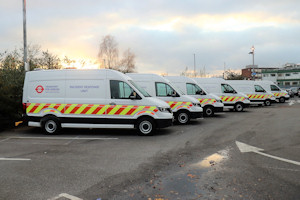 |
By Derek Everson Morden appears to have been one of the last locations to operate red Mercedes IRU (Incident Response Unit) vans, these all having been replaced by new, white-based Volkswagen Crafters by November 2020. This splendid view of the sun rising over the car park on 24th November 2020 shows six Crafters present, though the allocation here is believed to actually total 8 or 9 vans. From left to right the vans were 9085VW, 9099VW, 9062VW, 9098VW, 9068VW and 9055VW. This photo makes an interesting comparison with one also taken by Derek at the same location two years previously. |
28/11/2020 |
| 1,780 | 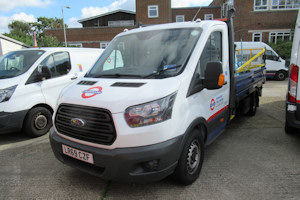 |
By Ray Monk After a bit of a lull in deliveries, no fewer than 22 new Ford Transit dropside trucks were received in the last three months of 2019. Fleetnumbers were spread across a wide range, from 8760F to 9002F, suggesting that some had been on order for a while. Coming near the middle of that range, 8870F was new in November and (like most of the others) had a tail-lift but no crew cab. Observations suggest it is allocated to Acton Works, where it was photographed on 22nd August 2020. |
28/11/2020 |
| 1,781 | 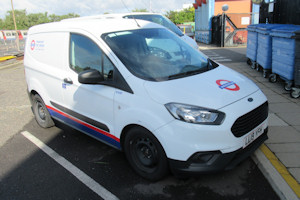 |
By Ray Monk The small Ford Transit Courier model was introduced in 2014 and has seen some use as a service vehicle by LUL. Apart from a few one-offs, largish batches were allocated to each of Lillie Bridge (believed to be for Ultrasonics) and Frank Pick House (Lifts and Escalators). The latter's initial ten were replaced by nine new examples in July 2019, while the Lillie Bridge batch started being renewed a year later. 8769F is one of the nine allocated to Frank Pick House, though it is not often to be found there. It was resident for a while from late-August 2020, and Ray photographed it outside the main building on 5th September. The van's appearance is slightly spoiled by having lost both of the smart wheeltrims on the offside. |
28/11/2020 |
| 1,782 | 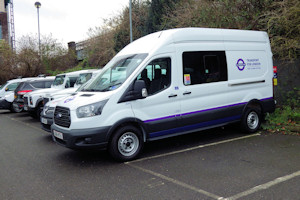 |
By Ray Monk The new Berlin Brandenburg Airport was recently opened a staggering nine years later than originally planned. Construction work was in fact essentially completed in 2011 (including a new railway line and station), but various technical issues caused massive delays to the actual opening. This put me in mind of the Crossrail project, work on which has been continuing at a reduced rate during the COVID-19 pandemic. As of August 2020, the proposed date for opening of the central section of the Elizabeth Line is in the first half of 2022. The white/blue/purple service vehicles do seem to be seeing some use, with visitors to the Plumstead depot finding a different set of vehicles present each time. Ford Transit crew van 8649F has been seen at Plumstead a few times, but for a better photo I have gone back to 18th December 2018, when the 2-month old van was parked in the car park at Acton Works. A gaggle of LUL Renault Kangoos were also present, while more interesting were the two Land Rover Defenders, believed to be LP15VJA and LP15VHN, latterly based at Arnos Grove. |
28/11/2020 |
| 1,783 | 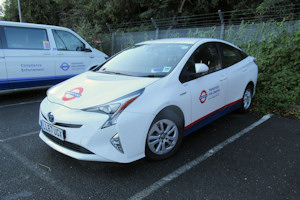 |
By Ray Monk LUL currently has 47 Toyota Prius cars in the liveried fleet, some of which are more elusive than others. 8624T is based at Hainault Depot in north east London and was not photographed until it returned to Acton Works in August 2020. It was still in the car park there when photographed on the 5th of September. |
28/11/2020 |
| 1,784 | 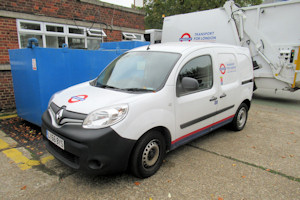 |
By Ray Monk I used to try and do at least one night expedition a year, usually starting at Griffith House. It was normal to find at least 20 service vehicle parked on nearby streets at about midnight, the vans then heading off to their work sites. As such, the vehicles were (relatively) easy to photograph, and much of the large allocation was covered. I have not managed any trips in the last few years, so we are reliant on day-time sightings of the vehicles for photographs. A few have been found parked up on residential streets, while others have been found on visits to Acton Works. One of the latter was Renault Kangoo (not Maxi) van 8358R, seen at Acton on 24th October 2020. Note the lack of fleetnumber (on the nearside only). In the background is one of the 2-axle Econic dustcarts with NTM bodywork (WO66HFL/HFM). |
28/11/2020 |
| 1,785 | 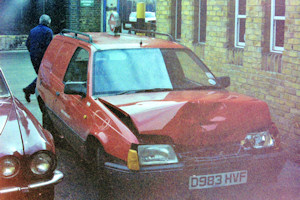 |
By Philip Hambling Photographed at Ash Grove Garage in February 1987, 3464B was a rather typical 1980s Inspector's vehicle, being a Bedford Astra van complete with roof-mounted roundel. It had evidently had a bit of a bump to the front end, though other photos suggest it was repaired and returned to service within 2 months. |
28/11/2020 |
| 1,786 | 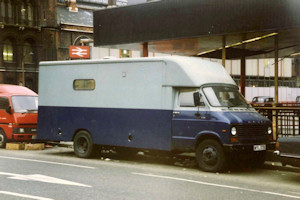 |
By Philip Hambling From 1982, new vehicles that were leased instead of purchased (these tending to be the smaller cars and vans) were given fleetnumbers in a new series starting at 3000. This meant that the traditional number series (which had been used continuously since 1939) saw far fewer additions. Apart from one late-running car (2370B in January), just seven new fleetnumbers in the original series appeared in 1982. Undoubtedly the most interesting of those seven was 2375D, a Dodge S50 new in July with a box body fitted out as a mobile laboratory. It had a small window in each side and some equipment hatches in the nearside, while the rear end had twin hinged doors for access, along with a step. The livery was a unique navy blue lower half and grey upper half, and the only lettering carried was the fleetnumber and LTE legal lettering. Used by the research laboratory at Chiswick Works, it was later joined by Bedford Midi van 2457B in standard red livery. Both vehicles were seen parked outside Kings Cross Station in November 1987, no doubt investigating the tragic fire that occurred there on the 18th. The research laboratory became LUL Scientific Services in 1987 and was moved from Chiswick Works to the new Frank Pick House on Bollo Lane (now used by Lifts and Escalators) and received one more new vehicle (Ford Transit van 2507F) before being closed down in 1996. 2375D had been withdrawn in 1991. |
28/11/2020 |
| 1,787 | 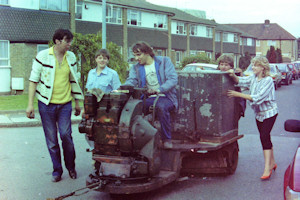 |
By Philip Hambling I'm going to end today's batch of photos with something a bit unusual. Few people took any notice of the garage sweepers owned by London Transport, and it might be fair to say that they were a minority interest within a minority interest (service vehicles) within a minority interest (the LT fleet). However, they were liked by a couple of people who took notes of ones they found. The chap in this photo went one step further. He worked at Edmonton Garage and, when that was closed in February 1986 (and he was transferred to Stamford Hill), he had towed Edmonton's sweeper home and put it in his garage! Phil met the man at a rally later in the year and was invited to come and see the sweeper at its new home in Ponders End. After some tinkering and a few helpers to push, the machine started up. The only lettering visible in this view is a letter N on the nearside of the water tank, but the vehicle is apparently L20, a Lister new in the 1960s and previously allocated to Enfield. Whether it still survives is not known. |
21/11/2020 |
| 1,788 | 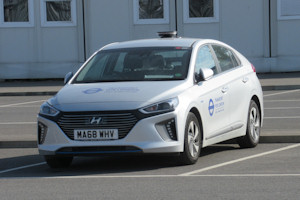 |
By Ray Monk The details of the TfL Highways operation remains something of a mystery to us, and (for the time being) the car shown in this photo is not included in the database. Seen at the North Greenwich Highways Alliance base on 31st August 2019, MA68WHV is a Hyundai Ioniq hybrid car similar to MK19FLC apart from having an even smaller light bar. To recap the situation, the London Buses infrastructure section was transferred to TfL in late 2016, and new vehicles were now in white/blue rather than red (although 8267VW was the only known example). A few months later, the fleet was moved from its traditional locations (mainly at bus stations such as Orpington and Stratford) to 'somewhere else'. It was later discovered that they had gone to Highways Alliance bases, including ones at Harlesden and Picketts Lock. The remaining red vans were then then disposed of during 2018, seemingly being replaced by un-numbered vans like OU68NUV. Although carrying TfL lettering, these were not supplied by Acton Works, and hence we did not know how many there were. The Highways Alliance bases also have cars allocated, mainly with a yellow stripe and lettering like that seen in the Morden photo linked above, though two at North Greenwich were silver with TfL markings. The fact that there have been no further reports of similarly-marked cars (or vans) over the past 2 years suggests that there might not be many of them. Having said that, a small van was recently noted parked at Turnpike Lane bus station in the same livery as the van photo linked above, but with the yellow stripe lower down. To add to the unknowns: 8267VW appears to still be current but its whereabouts are unknown. A newer Ford Transit van (8863F) is apparently in a similar livery. Role and allocation unknown. Fourteen Toyota Yaris cars in TfL white/blue were leased in 2019 (numbered between 8836T and 8899T), most of which have not been seen since delivery. I had intended to pay a visit to Picketts Lock once the COVID lockdown was eased, though it looked like a long walk and I didn't manage it before Lockdown 2 started. So, I have been limited to on-line hunting. I found one resource which I thought might prove useful, this being an interactive map showing land owned by (or leased to) TfL, LBSL, LUL and the Greater London Authority. I have spent some time browsing this map, but have not yet found anything that might help answer these questions. The site is worth a look anyway, and it can be found at https://tfl.maps.arcgis.com/apps/webappviewer/index.html?id=5129c766255941d3be16a6828faa8f18. |
21/11/2020 |
| 1,789 | 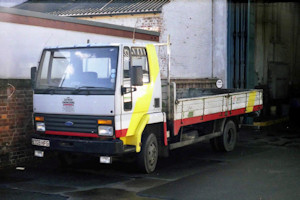 |
By Philip Hambling Most of the larger bus companies in the UK had their own engineering works, to repair and overhaul their bus fleets. In the run up to privatisation in the 1980s, most of these works were separated into stand-alone companies. London Country's main works was at Crawley, and ownership of this was transferred to new company Gatwick Engineering. They took on a proportion of the LCBS service vehicle fleet, including the three newest Ford Cargo lorries 66F to 68F. The traditional National Bus Company green was quickly replaced by a white livery with red and yellow detailing in a style that is very '80s' to me. B703HFG (the former 66F) was photographed at Guildford Garage in January 1989, by which time the new livery on the dropside body had been worn away in places, to show traces of the original markings beneath. As with most of the new companies, Gatwick Engineering was destined to not last very long. They were free to look for work beyond their parent bus companies (as evidenced in this photo of the BEL premises in Willesden) but very few attained commercial viability and most were soon closed down. |
21/11/2020 |
| 1,790 | 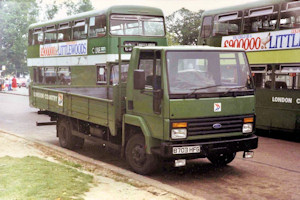 |
By Philip Hambling The last lorries bought new by London Country Bus Services (LCBS) were a trio of Ford Cargo dropsides in late 1984. Given fleetnumbers 66F to 68F none have been shown on LTSV. Until now! The first of the trio (66F) was a Cargo 0811 lorry, the other two being the slightly larger 1011 model. 66F was photographed in Crawley Bus Station in June 1986, a couple of months before LCBS was split up into four regional companies. The buses in the background are both AN class Leyland Atlanteans. The one on the left has the C Line local fleetname used on Crawley services and retains the original white waist band. The one on the right has the pale green band introduced by LCBS in about 1985. |
21/11/2020 |
| 1,791 | 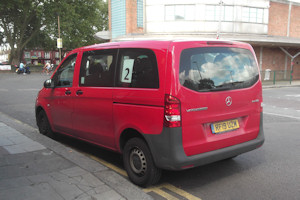 |
By London Spotter Go-Ahead London has at least 46 Mercedes-Benz Vito minibuses in unmarked red. They are used for crew ferry duties from seven of the group's garages. I don't intend to publish photos of every one of these largely identical vehicles, although I have already covered more than half of them. Today's addition is Northumberland Park's RF19UZM, seen at Turnpike Lane Bus Station on 1st August 2020. London Spotter's camera seems to capture the shade of red on these vehicles very slightly differently to everyone else's, as seen also on his photo of RX18LLC. It's not serious enough for me to try and mess about with post-processing though. |
21/11/2020 |
| 1,792 | 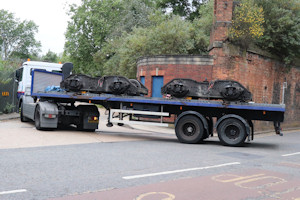 |
By Derek Everson This photo taken at the Bollo Lane entrance to Acton Works on 4th June 2019 highlights the relatively short length of Cartwright flat-bed trailer T74. It was coupled to Mercedes-Benz Actros tractor unit WP61ZXE and was loaded with two plate bogies. I suspect that these are off A or C type surface stock trains, although the last of these was withdrawn from passenger service in 2014. Interestingly Derek also photographed the same tractor/trailer combination in almost exactly the same place in 2017, when the trailer was also loaded with two identical plate bogies. Comparison of the two photos suggests that T74 had been given a new headboard in the intervening period. The checkerplate infill is obviously new, but the round-cornered framing of the headboard also appears to have been renewed. Another change is that there is now a pair of stanchions/handrails at the rear corners of the flatbed. Trailers always tend to last longer than other vehicles, and T74 is now nearly 18 years old. |
21/11/2020 |
| 1,793 | 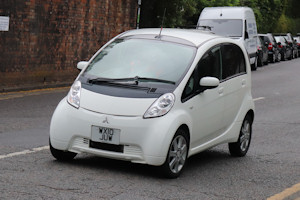 |
By Derek Everson It surprised me when I realised that this car is now one of the oldest vehicles remaining in the central fleet. WX10JUW was one of four Mitsubishi i-MiEV electric cars taken on by TfL Streets in June 2010 and based initially at Chancel Street in Southwark. All four wore the orange stripe livery with 'London Streets' lettering. In the period 2012 to 2014, all four seem to have been moved to Acton Works and had their lettering removed. At least three also lost their orange stripes, leaving them in unmarked white. Three were sold/returned in 2015 but WX10JUW remained, now used as a local runabout by the DSM. Judging by reports, it is only used between the various sites in and around Acton Works. On 4th June 2019 Derek caught the car coming down Bollo Lane. |
21/11/2020 |
| 1,794 | 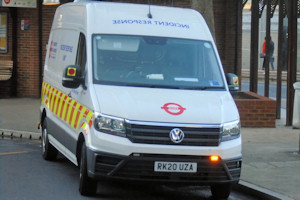 |
By Peter Terry Just three 20-registered IRUs were delivered before the imposition of the first lockdown in response to the COVID pandemic. 9068VW was the first (numerically) of this trio and on 6th October 2020 it was photographed in half-light at West Croydon Bus Station. Not knowing if this was early morning or late afternoon, I looked at the file properties. However, I have learned not to rely on EXIF data, as it is dependent on contributors having the date/time set up correctly on their cameras. This photo claims to have been taken at 11pm.... in March 2017! |
21/11/2020 |
| 1,795 | 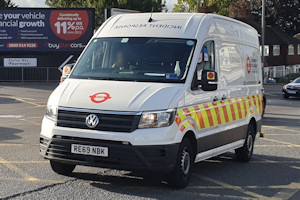 |
By Neal Marshall 9062VW was one of the first Volkswagen Crafter IRUs to enter service, having been delivered in early February 2020 and allocated to Morden. On the 22nd August it was caught heading down Purley Way. |
21/11/2020 |
| 1,796 | 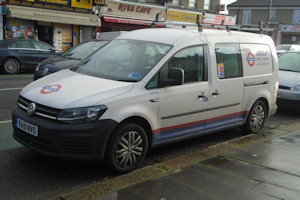 |
By Peter Terry There are about 120 Volkswagen Caddy Maxi crew vans in the current LUL fleet, making it one of the most numerous single types, eclipsed only by the similar-sized Renault Kangoo Maxi van. 8951VW was one of 60 of the type delivered in 2019 and appears to be based at Stratford Market Depot. It has also been reported a few times parked on Mitcham Road in Croydon, and Peter photographed it there on 10th November 2020. |
21/11/2020 |
| 1,797 | 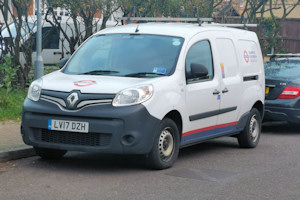 |
By Ivor Norman Ivor Norman recently sent in a couple of photos of LUL Renault Kangoo Maxi vans, both of which were taken in Harlow. Interestingly, both of the vans were among the 'lesser-spotted' of the type. The older of the pair was 8455R, photographed on 12th November 2020. This van is over three years old but has only been reported a handful of times, and never anywhere further south than Edgware. It is also one of very few vehicles that have not been seen by either of the two main SV-neds; Ray and Steve. Note that the van has a roof-rack of sorts, not a common feature on LUL Kangoos. |
21/11/2020 |
| 1,798 | 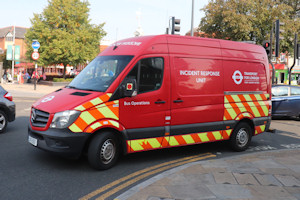 |
By Derek Everson The protracted delivery of the large batch of Volkswagen Crafter Incident Response Unit vans for London Buses in 2020 meant that many of the previous generation of Mercedes-Benz Sprinter vans had a stay of execution. Although similar in configuration, the two types can be easily distinguished since the Volkswagens feature a white base colour instead of the red on the Mercedes. The last of the Crafters was eventually delivered to Acton Works in October 2020, and it looks as though all the Sprinters had gone by early November. Among the last were four based at Morden station, including 7853M seen passing through Mitcham on 15th September 2020. |
21/11/2020 |
| 1,799 | 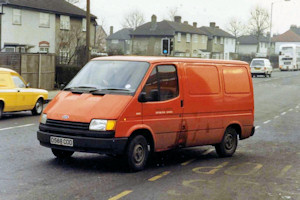 |
By Philip Hambling As mentioned before, when the Mk3 Ford Transit replaced the Mk2 as the standard mid-sized van for London Transport, the default livery changed from grey to red. The red on this example looks a little bit orangey, but that may just be a result of the photography/printing/scanning process. 3386F was a short-wheelbase, low-roof van leased in January 1987 and allocated at first as a cover vehicle for the Group 2 fleet. The 'Groups' dated back to the 1946 reorganisation of the fleet. Group 1 were special-purpose vehicles such as breakdown tenders. Group 2 vehicles were those used by specific departments such as advertising, while Group 3 was for general purpose vehicles operated by Central Distribution Services. 3386F had the traditional gold London Transport lettering (which was destined to disappear over the next couple of years), below which was Distribution Services in white. It was photographed leaving Enfield Bus Garage in February 1987, with an Eastern National Bristol VRT bus in an all-over advert heading the other way. |
21/11/2020 |
| 1,800 | 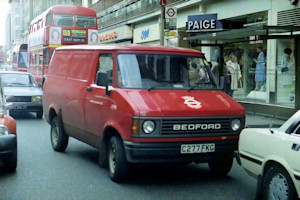 |
By Philip Hambling Between 1977 and 1990 London Transport operated a total of 79 Bedford CF vans as alternates to the similarly-sized Ford Transit model. Unlike the Transits of this era (which were mostly grey), all of the CFs were red, though there is some doubt about 3037B, which may have also been grey. Most of the CFs, particularly those added after the adoption of the new numbering series for leased vehicles in 1982, were for use by the publicity and advertising department. 3329B was a one-off, leased in 1985 for use by the Operations Manager (Buses) from Gillingham Street Bus Garage in Victoria. It replaced similar 3078B, which had in turn replaced similar 2119B in 1982. According to official documents, 3329B was withdrawn in September 1989 when it was replaced by Ford Escort estate car 3749F. Phil caught 3329B on Oxford Street in May 1986, showing the Abbey District sticker applied to the bonnet. The bus stop behind, and the Routemaster bus following, both show the yellow highlighting used to distinguish 'tourist' bus routes. |
21/11/2020 |
| < Previous (later) 100 | Next (earlier) 100 > |